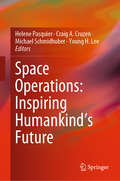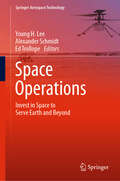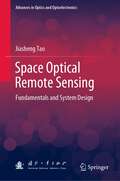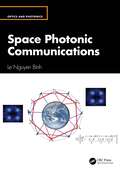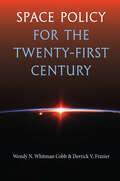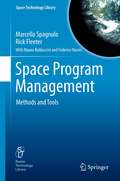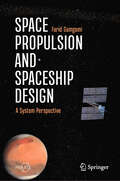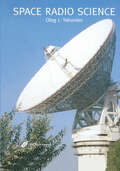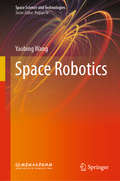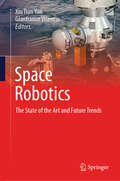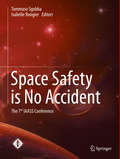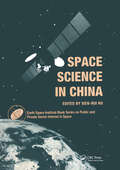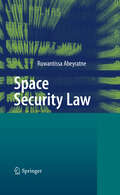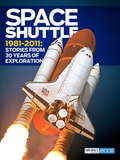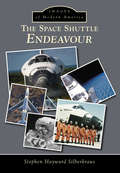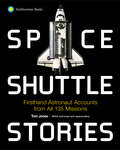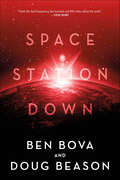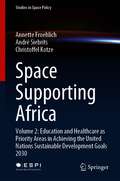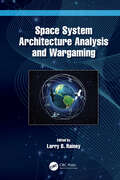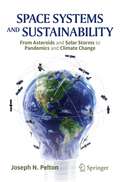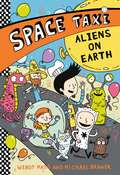- Table View
- List View
Space Operations: Inspiring Humankind's Future
by Michael Schmidhuber Young H. Lee Helene Pasquier Craig A. CruzenThis book includes a selection of 30 reviewed and enhanced manuscripts published during the 15th SpaceOps Conference held in May 2018 in Marseille, France. The selection was driven by their quality and relevance to the space operations community. The papers represent a cross-section of three main subject areas: Mission Management – management tasks for designing, preparing and operating a particular mission Spacecraft Operations – preparation and implementation of all activities to operate a space vehicle (crewed and uncrewed) under all conditions Ground Operations – preparation, qualification, and operations of a mission dedicated ground segment and appropriate infrastructure including antennas, control centers, and communication means and interfaces This book promotes the SpaceOps Committee’s mission to foster the technical interchange on all aspects of space mission operations and ground data systems while promoting and maintaining an international community of space operations experts.
Space Operations: Invest in Space to Serve Earth and Beyond (Springer Aerospace Technology)
by Alexander Schmidt Young H. Lee Ed TrollopeThis book includes a carefully curated selection of contributions that were presented at the 17th International Conference on Space Operations (SpaceOps) held in Dubai, UAE, from March 6th to 10th, 2023. The selection of chapters was based on their relevance to the current space operations community. The contributions represent a cross-section of three main subject areas: Mission Management—management tasks for designing, preparing and operating a particular mission; Spacecraft Operations—preparation and implementation of all activities to operate a space vehicle (crewed and uncrewed) under all conditions; and Ground Operations—preparation, qualification, and operations of a mission dedicated ground segment and infrastructure, including antennas, control centers, and communication means and interfaces. The book highlights the SpaceOps Committee’s objective to encourage the exchange of technical knowledge regarding space mission operations and ground data systems. Additionally, it emphasizes the significance of establishing and sustaining a global community of experts in space operations.
Space Optical Remote Sensing: Fundamentals and System Design (Advances in Optics and Optoelectronics)
by Jiasheng TaoThis book highlights the fundamentals, technologies, and methods of space optical remote sensing and system design. The author introduces concepts and methods established during his decades of research and practice, covering topics such as difference between the spatial resolution of pixel and the resolution of traditional film, the resolution of remote sensing image for characteristics and target recognition purpose, and image shift problem of sampling image space. The book comprehensively and systematically introduces the basic concepts, theories, parameter design calculations of imaging cameras, multispectral cameras, surveying cameras, infrared cameras, and imaging spectrometers, their respective system components, and performance evaluation of space optical remote sensing systems. The book also discusses the overall design of space optical remote sensing systems, including light sources, the ground-air system, target characteristics, spectrum selection, energy calculation, orbital parameters, optical remote sensor parameters, spacecraft parameters coordination and selection, comprehensive analysis, and large-scale system performance evaluation methods, forming a complete idea on how to achieve the goals of the system design. The book enables readers to understand the working principles of the whole systems from a theoretical depth and grasp the full skillset on how to implement advantages and balance technical difficulties for orbit, subsystems of the platform, and payloads. The book is a must-read for those who seek to build strong ability for research, development, and innovation surrounding the subject matter.
Space Photonic Communications (Optics and Photonics)
by Le Nguyen BinhThis book explores the extension of fiber optic communications technology to space optical communications. It presents the specific demands for space communications and examines propagation in a vacuum and also over the turbulence of air‑free space.Space Photonic Communications begins with historical aspects of optical communications in both terrestrial and inter‑satellite constellations. It presents the advances in optical communications and integrated photonics that have enabled the technological developments for space photonic communications, especially coherent optical communications to transport Tbps information. The author discusses how the transmission of massive amounts of data over very long distances requires Tera‑bps communications in real time for both military and civil applications. The author also explores laser communications with the physics of laser propagation over ultra‑long distances without optical amplifications at intermediate locations. He also examines modulation and receiving techniques for space photonic communications.Intended for communications engineers and professionals, especially those in laser communication technologies, this book could also be used in courses on advanced optical communications, photonic communications, and communication techniques and technologies.
Space Piracy: Preparing for a Criminal Crisis in Orbit
by Hugh Taylor Marc FeldmanComprehensive exploration of humanity's potential for criminal activities in outer space Space Piracy: Preparing for a Criminal Crisis in Orbit is a forward-thinking resource that considers, analyzes, and provides solutions to the influence of the ignoble side of humanity in the realm of outer space, where potential for crime, corruption, piracy, and war increases as the exploitation of space as a commercial resource continues to develop. This book blends the authors' knowledge with that of subject matter experts to deliver a holistic understanding of criminality in space and help readers broaden their horizons beyond their own area of specialization. Some of the topics explored in this insightful book include: Space hacking, from software, data, network, and hardware risks to existing cybersecurity standards and practices in space Criminal organizations that might pursue criminal activities in space, including cartels, kidnappers and devicenappers, and governments Laws and treaties relevant to space crime, such as the Communications Satellite Act and the Outer Space Treaty of 1967 Filled with practical, thought-provoking knowledge and guidance, Space Piracy: Preparing for a Criminal Crisis in Orbit earns a well-deserved spot on the bookshelves of professionals working in the best of humanity's institutions, including law and intelligence services, finance, insurance and risk management, corporations, and the sciences, who seek to combat what the worst of us may be dreaming up.
Space Policy for the Twenty-First Century
by Wendy N. Whitman Cobb Derrick V. FrazierA foundational, accessible overview of space policy in the United States This book provides readers with the first comprehensive overview of major space policies in the United States and a framework through which to analyze them. It examines all facets of space policy—civilian, military, and commercial—and presents this material accessibly for use by readers at multiple levels, from undergraduate courses to government practitioners making and implementing policy. The first section offers a history of space exploration, focusing on the US within a global context. The second section looks at the actors and institutions involved in setting space policy in a government based on the separation of powers, including the president, Congress, NASA, and the Department of Defense. The book concludes with chapters on the different sectors of space policy, as well as questions this field will face in the future. As policymakers and business leaders become increasingly aware of the everyday systems that depend on space technologies, such as communications, mapping, and weather monitoring, and as space becomes a more visible arena for commercial competition, potential humanitarian gain, and military threats, Space Policy for the Twenty-First Century helps students and professionals navigate the complexity of space as a policy area.
Space Program Management
by Marcello Spagnulo Federico Nasini Mauro Balduccini Rick FleeterBeginning with the basic elements that differentiate space programs from other management challenges, Space Program Management explains through theory and example of real programs from around the world, the philosophical and technical tools needed to successfully manage large, technically complex space programs both in the government and commercial environment. Chapters address both systems and configuration management, the management of risk, estimation, measurement and control of both funding and the program schedule, and the structure of the aerospace industry worldwide.
Space Propulsion and Spaceship Design: A System Perspective (Springer Praxis Books)
by Farid GamgamiThe objective of this textbook is to provide a synopsis of propulsion technologies in the context of spaceship design. The author identified a lack of multidisciplinary textbooks that explain to students both the technology and physics of space propulsion as well as its relationship to other disciplines in the process of spaceship design. To make the subject more tangible, the propulsion demanding context of space exploration was chosen. The book therefore begins with the astronomical context relevant to human exploration of the solar system. This challenging endeavour requires powerful space propulsion systems of various types. Existing and emerging technologies are systematically discussed. Principle similarities and technological analogies between the different types are highlighted. Starting from the physical working principle, the book progressively extends the view to subsystem and system design aspects. This approach recognises that the propulsion subsystem is the most defining architectural element of large spacecraft, i.e. starships. Such a comprehensive presentation of propulsion technology from a system perspective is not yet reflected in the existing literature. In order to apply the fundamental knowledge provided in the first 9 chapters, a mission to the dwarf planet Ceres is presented, where different propulsion technologies have to be combined to achieve the mission objectives. In this way, the reader is introduced to the basics of requirements breakdown, design space analysis and the technical trade-off process, all of which are essential for early mission planning. The book is aimed at advanced undergraduate and graduate students, recent postgraduates, and newcomers to the field of spacecraft design where propulsion is essential.
Space Radio Science (Earth Space Institute Book Series)
by O.I. YakovlevSpace Radio Science outlines space communications with Earth's satellites and interplanetary probes, interstellar radio communications within our galaxy, and the effects of gravitational fields on propagating radio waves. The text describes a method of radio occultation used to monitor planetary atmospheres and ionospheres. The author considers the remote sensing of circumsolar and interplanetary plasmas as well as of the Earth and other planets in the solar system. He also analyzes radiophysical problems and methods, as well as the benefits of spacecraft and radio signals. This book is ideal for radio-physicists, engineers, and students in space radiophysics, remote sensing, and space communications.
Space Robotics (Space Science and Technologies)
by Yaobing WangThis book provides readers with basic concepts and design theories for space robots and presents essential methodologies for implementing space robot engineering by introducing several concrete projects as illustrative examples. Readers will gain a comprehensive understanding of professional theories in the field of space robots, and will find an initial introduction to the engineering processes involved in developing space robots. Rapid advances in technologies such as the Internet of Things, Cloud Computing, and Artificial Intelligence have also produced profound changes in space robots. With the continuous expansion of human exploration of the universe, it is imperative for space robots to be capable of sharing knowledge, working collaboratively, and becoming more and more intelligent so as to optimize the utilization of space resources. For on-orbit robots that perform service tasks such as spacecraft assembly and maintenance, as well as exploration robots that carry out research tasks on planetary surfaces, the rational integration into a network system can greatly improve their capabilities in connection with executing outer space tasks, such as information gathering and utilization, independent decision-making and planning, risk avoidance, and reliability, while also significantly reducing resource consumption for the system as a whole.
Space Robotics: The State of the Art and Future Trends
by Xiu Tian Yan Gianfranco VisentinThis book presents the latest research findings from leading space robotic researchers around the world, together with contributions from leading space systems industrialists on the practical aspects of research and development in space robotics. The book also considers future challenges and trends to provide a ‘look ahead’ for space robotics. The European Commission set up the “Space Robotic Technologies” Strategic Research Cluster (SRC) in its flagship funding programme Horizon 2020, with the goal of enabling major advances in strategic key points of Space Robotics Technologies, in order to improve European competitiveness. Space robotics have advanced rapidly in recent years, as reflected in recent successful space exploration missions like NASA’s successful landing and operation of the Curiosity rover on Mars, and the European Space Agency’s equally successful landing of its Philae probe on comet 67P/Churyumov–Gerasimenko. These advances have inspired many young graduates and undergraduates to study space robotics.
Space Safety is No Accident
by Tommaso Sgobba Isabelle RongierIncludes the proceedings from the 7th IAASS Conference, "Space Safety is No Accident," held in Friedrichshafen, Germany, in October 2014. The 7th IAASS Conference, "Space Safety is No Accident" is an invitation to reflect and exchange information on a number of topics in space safety and sustainability of national and international interest. The conference is also a forum to promote mutual understanding, trust and the widest possible international cooperation in such matters. The once exclusive "club" of nations with autonomous sub-orbital and orbital space access capabilities is becoming crowded with fresh and ambitious new entrants. New commercial spaceports are starting operations and others are being built. In the manned spaceflight arena a commercial market is becoming a tangible reality with suborbital spaceflights and government use of commercial services for cargo and crew transportation to orbit. Besides the national ambitions in space, the international cooperation both civil and commercial is also gaining momentum. In the meantime robotic space exploration will accelerate and with it the need to internationally better regulate the usage of nuclear power sources. Space-bound systems and aviation traffic will share more and more a crowded airspace, while aviation will increasingly rely on space-based safety-critical services. Finally, most nations own nowadays space assets, mainly satellites of various kinds and purposes, which are under the constant threat of collision with other spacecraft and with the ever increasing number of space debris. Awareness is increasing internationally (as solemnly declared since decades in space treaties) that space is a mankind asset and that we all have the duty of caring for it. Without proactive and courageous international initiatives to organize space, we risk to negate access and use of space to future generations.
Space Science in China (Earth Space Institute Book Ser. #Vol. 1)
by Wen-Rui HuSpace science in China is one of the most active areas in modern science, and China has played a dynamic and steadily increasing role in this field since the 1960s. Until recently, however, activity in China was a mystery to the rest of the world. With the commercial importance of space, and the fact that space is now used as a laboratory to carry out various experiments, China has recently emerged as an important international competitor. Space Science in China provides a clear understanding of the latest research and progress in such wide-ranging areas as the development and research in solar-terrestrial science, space astronomy, geoscience, remote sensing, microgravity science, and life science.
Space Security Law
by Ruwantissa AbeyratneAgainst the variegated background of bewilderment and cautious optimism that space transportation offers, this book begins with an exposé on international politics, the principles of which, bear upon space transportation, as well as the closeness of air space and outer space, and activities that straddle both frontiers at the same time. It discusses current issues and possibilities of communications and transportation in outer space, as well as the liabilities and accountability of the key players of space exploration.
Space Shuttle 1981-2011
by Sally Ride T. A. Heppenheimer Air Space Magazine Greg FreiherrSpace Shuttle 1981-2011 is a lavishly illustrated special edition celebrating the space shuttle era. In thirty years of operation, space shuttles were used in 135 different missions; this volume presents the adventure stories of many of these missions in the astronauts' own words. Additional contributions by space exploration writers cover the history of the program, technological challenges and triumphs, scientific achievements, and the devastating Challenger and Columbia tragedies. Complete with more than 40 essays and 100 full-color photographs, Space Shuttle 1981-2011 is a captivating overview of this critical part of space history. Although the space shuttle era has ended, its spirit--that of limitless curiosity and a desire for perfection--continues to inspire.
Space Shuttle Endeavour, The (Images of Modern America)
by Stephen Hayward SilberkrausBorn out of tragedy and like none of her predecessors, over the course of her 25 missions and her 19-year career, this new orbiter would perform many vital and historic missions for humanity. Inspiring pride and admiration, Endeavour would fix the Hubble Space Telescope, begin construction of the International Space Station (ISS), and perform several Spacelab missions, never failing to expand man's knowledge of space. Endeavour's story was not to end with 25 missions in space but with one final mission, mission 26, her move from Florida to her new home in California. Atop the Shuttle Carrier Aircraft, Endeavour was flown piggyback across the United States for her final victory lap. Welcomed and waved along by millions of admirers, she was carried through the streets of Los Angeles to her final destination, the California Science Center in Downtown Los Angeles.
Space Shuttle Stories: Firsthand Astronaut Accounts from all 135 Missions
by Tom JonesExperience all 135 NASA space shuttle missions ever flown through the words of the astronauts themselves in this spectacularly illustrated volumeWith more than 600 photos from the NASA archives, this guide is perfect for fans of space history and spaceflightNASA's space shuttle was the world's first reusable spacecraft, accomplishing many firsts and inspiring generations across its 30-year lifespan as America's iconic spaceship. In Space Shuttle Stories, shuttle astronaut Tom Jones interviewed more than 130 fellow astronauts for personal vignettes from each mission, complemented by their written accounts for all 135 space shuttle missions, from Columbia's maiden flight in 1981 to the final launch of Atlantis in 2011. The book is a major contribution to the historical record of a momentous era of spaceflight.Each mission profile includes:An astronaut narrative that immerses the readers in their personal mission experienceData about the mission, crew, launch, landing, duration, and highlightsCaptivating photographs rarely seen by the publicThe Space Shuttle program&’s 6 orbiter vehicles (Enterprise, Columbia, Challenger, Discovery, Atlantis, and Endeavour) carried a total of 355 astronauts into orbit on 135 missions aimed at cutting-edge scientific research, satellite launch, retrieval and repair, collaborative work with the Russian Mir station, the launching and servicing of the Hubble Space Telescope, and the construction of the International Space Station. Space Shuttle Stories focuses on the lived, human experiences of larger-than-life space missions. It's a definitive oral history that captures the importance, wonder, and exhilaration of the Space Shuttle era.
Space Station Down
by Ben Bova Doug BeasonAn American astronaut fights to stop a massive terrorist plot from destroying the east coast in this action-packed technothriller.“Think Die Hard happening two hundred and fifty miles above the earth. . . . Will have you watching the skies overhead much more closely.” —Steve BerryFrom Hugo Award–winning author Ben Bova and Nebula Award finalist Doug Beason:When two rogue cosmonauts slaughter all but one astronaut on the International Space Sttion, the sole survivor, Kimberly Hadid-Robinson, barricades herself in a remote section of the station, wreaking havoc on the terrorists’ plans.The twisted terrorists plot to destroy the United States by obliterating New York City, the financial capital of the world, and raining down a million pounds of radioactive metal from Florida to Maine.As the station descends, Kimberly is in a race against time—not only to save her own life but the lives of millions!Praise for Space Station Down“One hell of a fine suspense novel.” —Stephen Coonts, New York Times–bestselling author“Wow! I found myself feeling like I was flying through the space stations. . . . And I should know—I’ve been there!” —Nicole Scott, International Space Station and space shuttle astronaut, spacewalker, and aquanaut
Space Studies Board: Annual Report 2014
by National Research Council of the National AcademiesUnder the leadership of Jonathan Lunine and Mitch Daniels, the Committee on Human Spaceflight completed one of the most challenging studies undertaken by the Space Studies Board and the Aeronautics and Space Engineering Board. In Pathways to Exploration: Rationales and Approaches for a U.S. Program of Human Exploration, a diverse committee of experts tackled not only the question, How should humans explore space?, but the even more challenging question, Why should humans explore space? <P> The committee identified a pair of enduring questions that motivate human spaceflight: How far from Earth can humans go? and What can humans discover and achieve when we get there? The committee then explored a range of rationales for human spaceflight ranging from the pragmatic (its economic, national security, scientific exploration, international relations, and technology impacts) to the aspirational—the notion that space is humanity’s future. While the committee did not identify a single rationale as the primary justification for space exploration and could not quantify the economic benefit of space exploration, it did conclude that a mix of rationales motivates space exploration. <P><P> Along with an examination of public and stakeholder attitudes about human exploration, the report evaluated three different pathways to illustrate the trade-offs among affordability, schedule, developmental risk, and the frequency of missions for different sequences of intermediate destinations. The pathways, all of which culminate in landing on the surface of Mars, include some combination of missions to asteroids, the Moon, and martian moons.
Space Supporting Africa: Volume 2: Education and Healthcare as Priority Areas in Achieving the United Nations Sustainable Development Goals 2030 (Studies in Space Policy #27)
by Annette Froehlich André Siebrits Christoffel KotzeThis book addresses the need to support decision-makers across Africa by promoting awareness of the importance of space technologies and data to African development through the presentation of existing examples where space supports education and healthcare, and by making recommendations for further roll-out of these efforts. This is necessary because of the enduring misconception that space-related research and expenditure competes with other, more pressing, needs on the continent, when in truth space can play a major role in meeting these needs.Accordingly, the book unpacks the United Nations Sustainable Development Goals (SDGs) 2030 and the critical needs they address in the African context. Secondly, it provides an analysis of the African higher education landscape and considers the network of higher education-related SDGs, their targets, and their indicators. Africa’s own development plan, Agenda 2063, is also explored. The African higher education landscape is then assessed by way of three models – the Space-Education Equation (SEE), the Benefits to Education by Space Transection (BEST), and the Enhanced Education for Sustainable Development Access and Success (EESDAS) model. The critical role of educational technologies and e-learning in bridging the educational access and success gap is appraised, as is the role of the space sector, and its technologies, applications, and data in African higher education. Finally, it explores e-health and provides an analysis of pertinent technologies required by e-health, past and present, and the opportunities and challenges it presents. Space technology can play a critical role in eliminating the barriers that are currently preventing e-health from playing a more significant role in a developing region such as sub-Saharan Africa.
Space System Architecture Analysis and Wargaming
by Larry B. RaineySpace System Architecture Analysis and Wargaming presents a single-source reference for two major topics that are not currently covered in literature related to subdisciplines of astronautics. It provides modeling and simulation tools to architect space systems and analysis, which include detailed discussions of various simulation tools: STK, SEAS, SOAP, AFSIM, EADSIM, and STORM.Working through the types of analysis that can be performed with each toolkit, the book focuses on designing and evaluating alternative space systems and system of systems to meet mission requirements. It also addresses the field of space wargaming with two tools: Space Warfare Analysis Tool/Space Attack Warning and Space and Information Analysis Model.The book is intended for professionals working in the fields of aerospace engineering, astronautical engineering, space systems engineering, and space wargaming. It will also interest graduate students who are studying spacecraft systems and space architecture.
Space Systems and Sustainability: From Asteroids and Solar Storms to Pandemics and Climate Change
by Joseph N. PeltonIn his latest book, space scientist, futurist, and educator Joseph N. Pelton explores adozen ways that Planet Earth is at “existential” risk, along with the many ways thatspace systems, data analytics, and advanced networking systems can help us copewith these global challenges.The chapters examine in a straightforward way how satellite systems and technol-ogy can drastically transform fields such as pandemic tracking and global medicalresponses, cosmic hazard monitoring, nuclear energy and waste disposal, water andland pollution, tele-education/telemedicine, and military conflict. Such examplesshow how orbiting smart systems will play an ever more vital role in our vulnerablemodern world, allowing us to monitor, track, and respond to mounting problems ofthe 21st century.Dr. Pelton takes a broad view, probing the social, economic, and regulatory factorsthat are crucial to creating a more sustainable “Spaceship Earth.” This book is a callto action, promoting more organized international collaboration and investment in space technologies that can enable global change.
Space Systems for Disaster Warning, Response, and Recovery
by Scott MadryThis SpringerBrief provides a general overview of the role of satellite applications for disaster mitigation, warning, planning, recovery and response. It covers both the overall role and perspective of the emergency management community as well as the various space applications that support their work. Key insights are provided as to how satellite telecommunications, remote sensing, navigation systems, GIS, and the emerging domain of social media are utilized in the context of emergency management needs and requirements. These systems are now critical in addressing major man-made and natural disasters. International policy and treaties are covered along with various case studies from around the world. These case studies indicate vital lessons that have been learned about how to use space systems more effectively in addressing the so-called "Disaster Cycle. " This book is appropriate for practicing emergency managers, Emergency Management (EM) courses, as well as for those involved in various space applications and developing new satellite technologies.
Space Taxi: Aliens on Earth (Space Taxi #6)
by Wendy Mass Michael BrawerArchie Morningstar fights crime across the universe alongside his dad and Pockets the talking cat. In his sixth adventure, the space taxi navigation system goes down, stranding all the alien passengers on Earth! Will the team be able to find hiding spots for these otherworldly creatures before they're discovered, or will this be the end of the operation for good? Get ready for another exciting intergalactic adventure.
Space Taxi: Archie Takes Flight (Space Taxi #1)
by Wendy Mass Michael Brawer Elise GravelArchie Morningstar learns a big family secret and helps save the universe. All before breakfast!It's not every day a regular kid like Archie gets to wake up at midnight. But today is Take Your Kid to Work Day, and Archie is finally allowed to ride along in his dad's taxi cab. He has been waiting eight years, eight months, and eight days for this moment to arrive.But he's about to discover his dad is no ordinary cab driver...In fact, he drives an intergalactic space taxi! All night long, he shuttles aliens from one corner of the universe to another. And being a space taxi copilot is no easy task: Archie must steer them into wormholes, keep them from crashing into planets, deal with a very unusual cat...and save the universe from an evil mastermind!Space Taxi marks the debut of a brand new chapter book series from New York Times bestselling author Wendy Mass and teacher Michael Brawer, filled with humor, adventure, and plenty of science to impress your friends and teachers!
